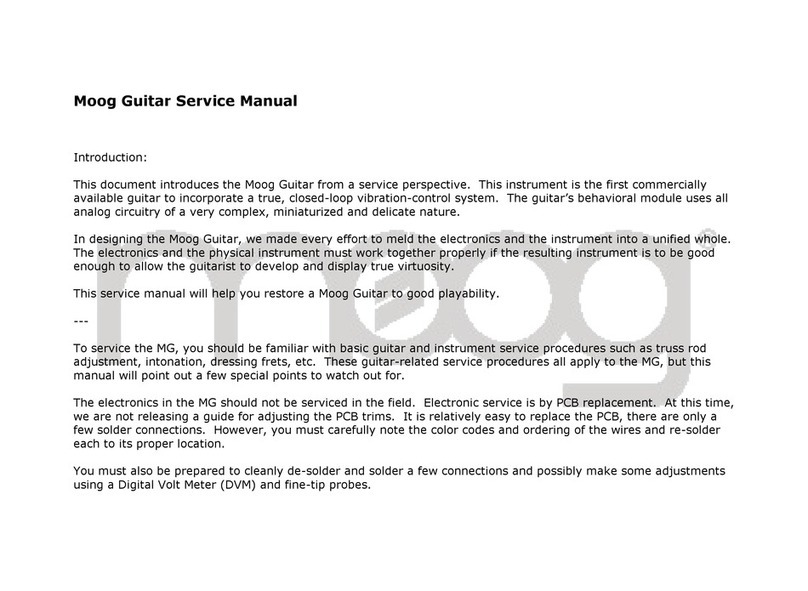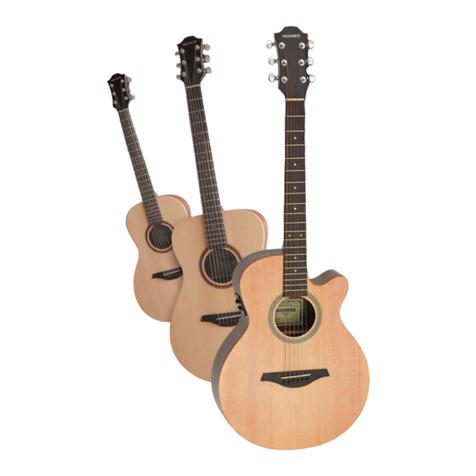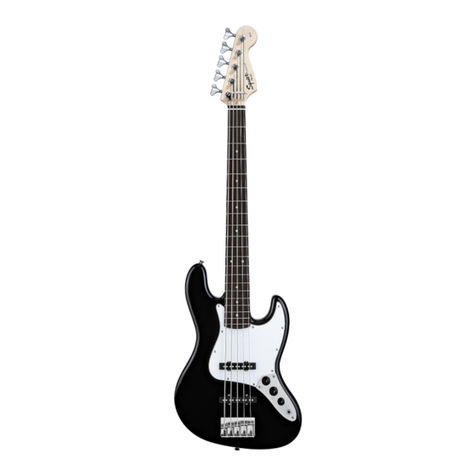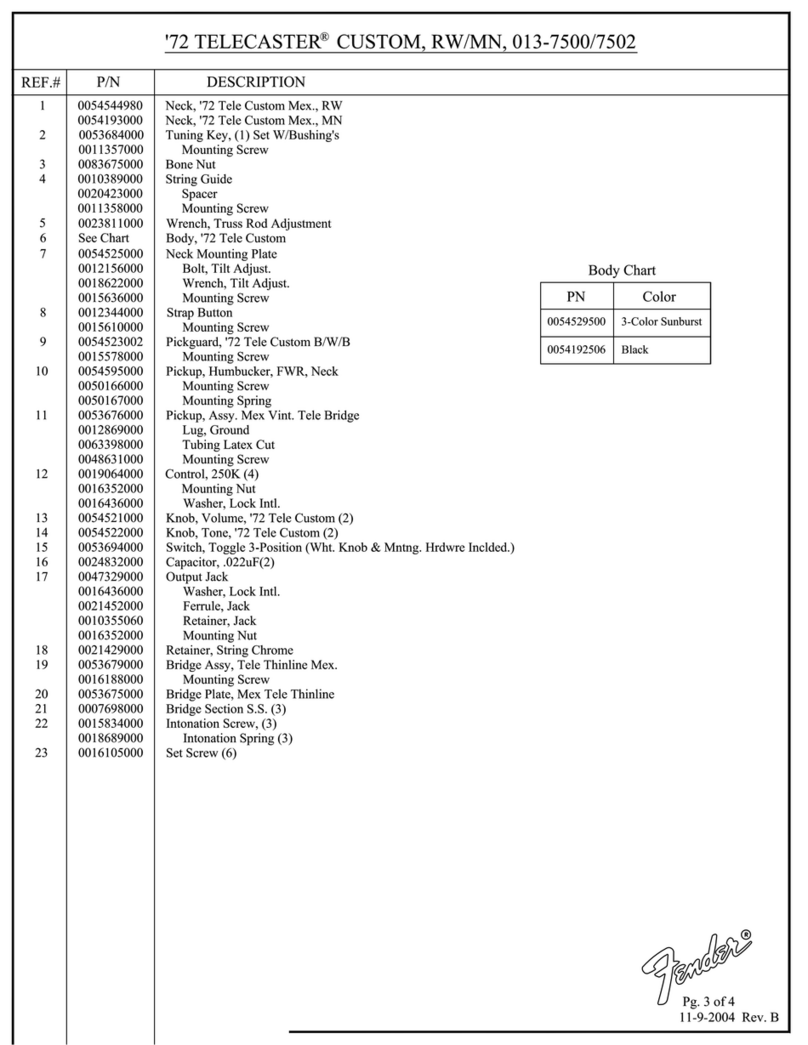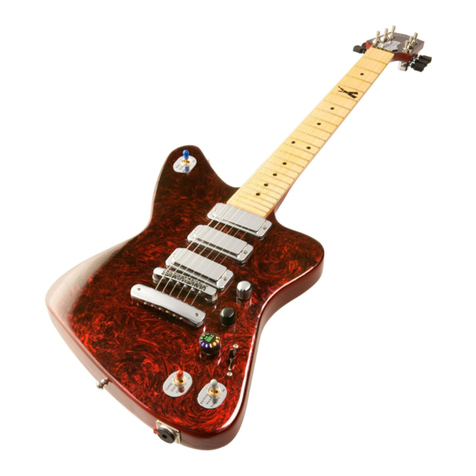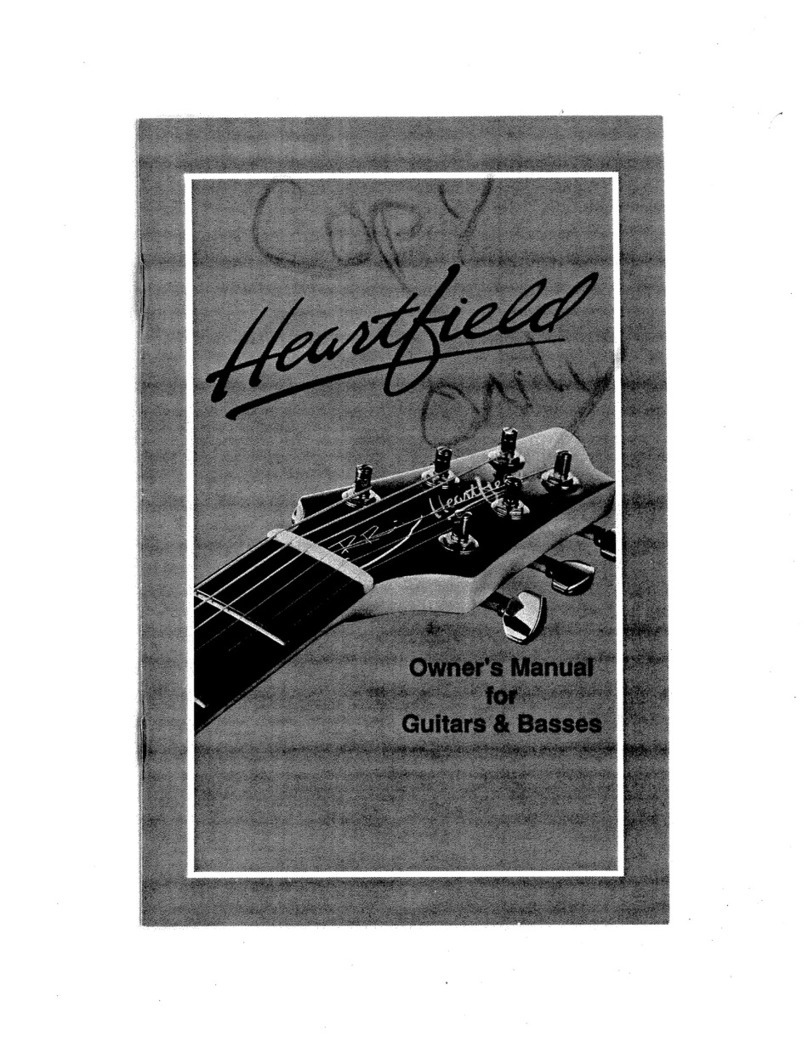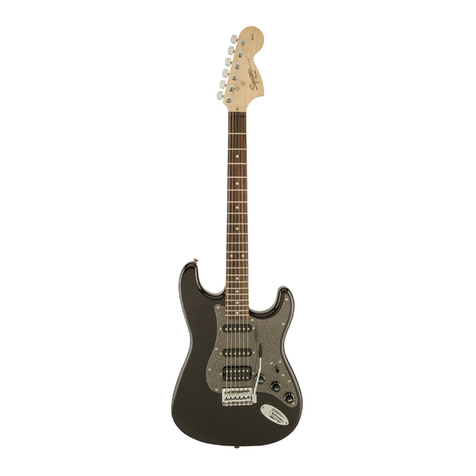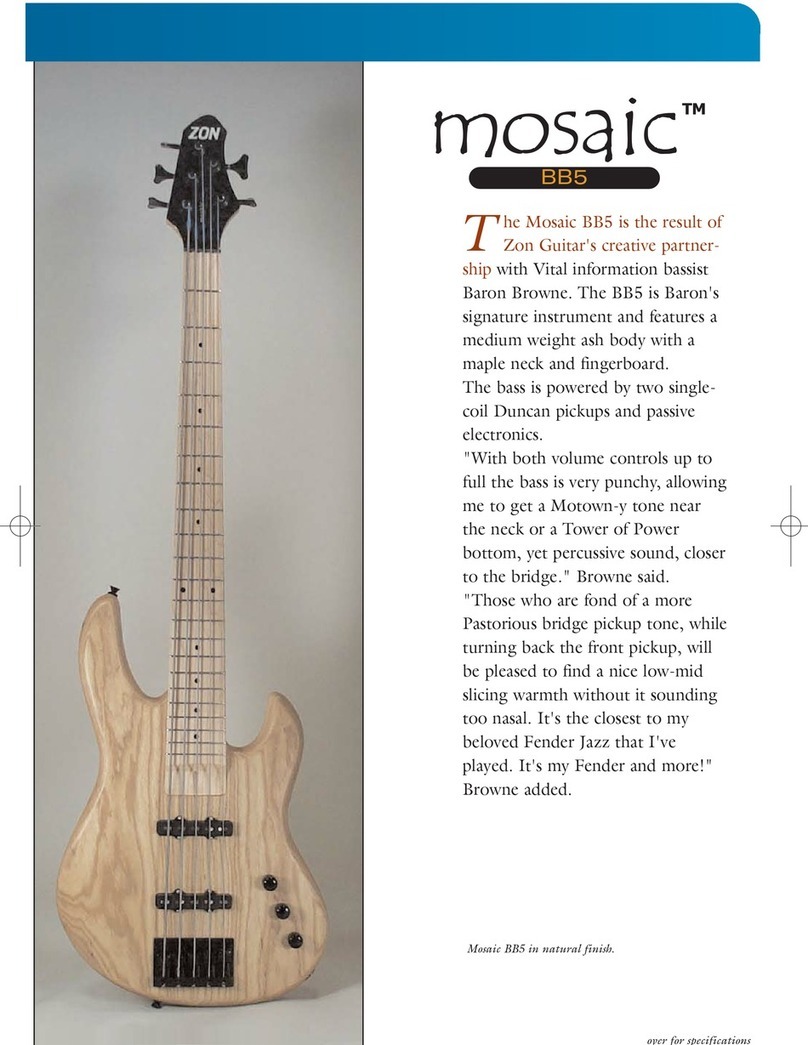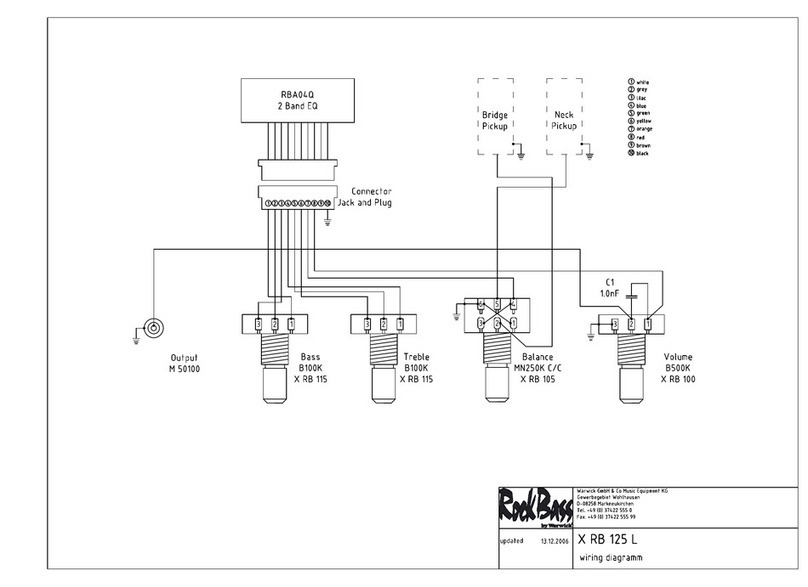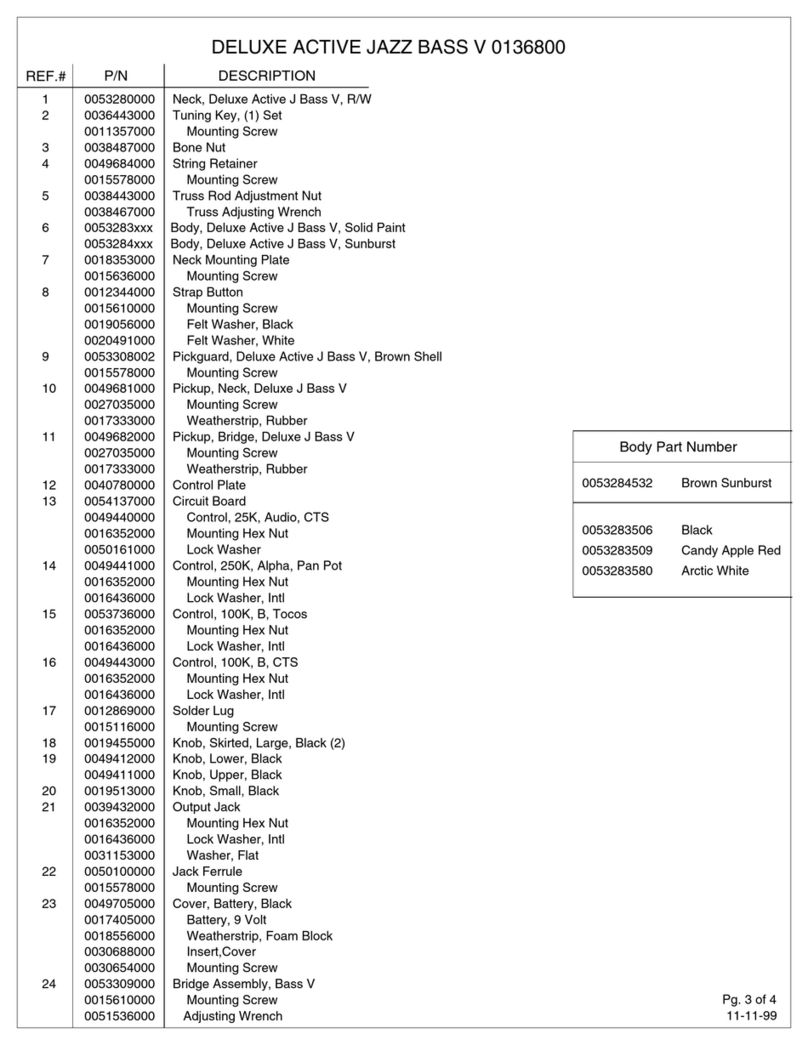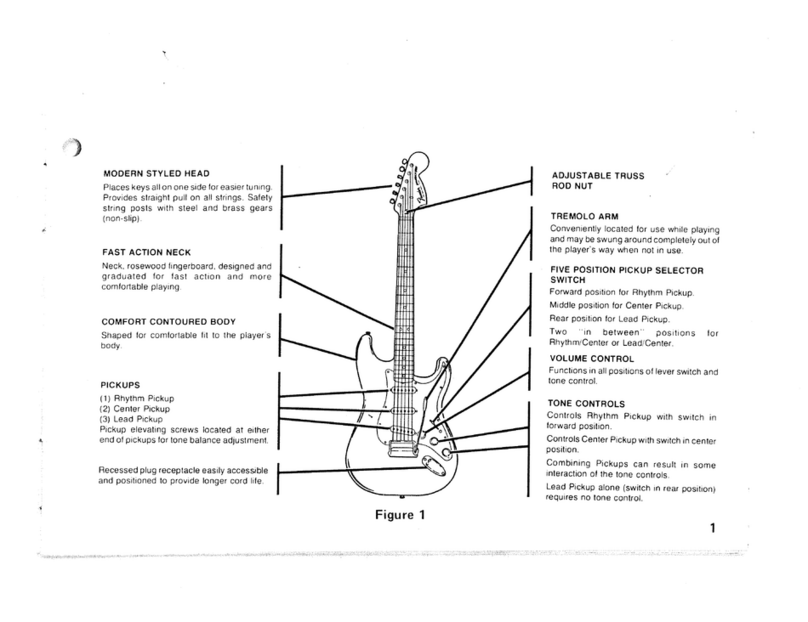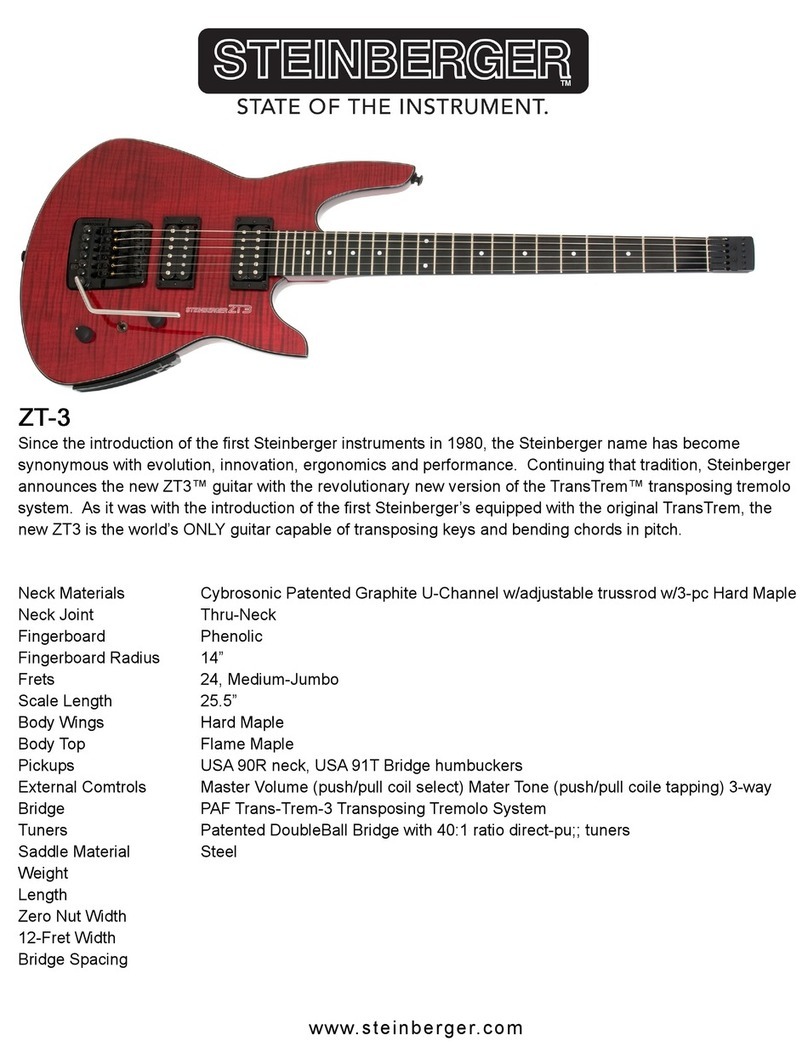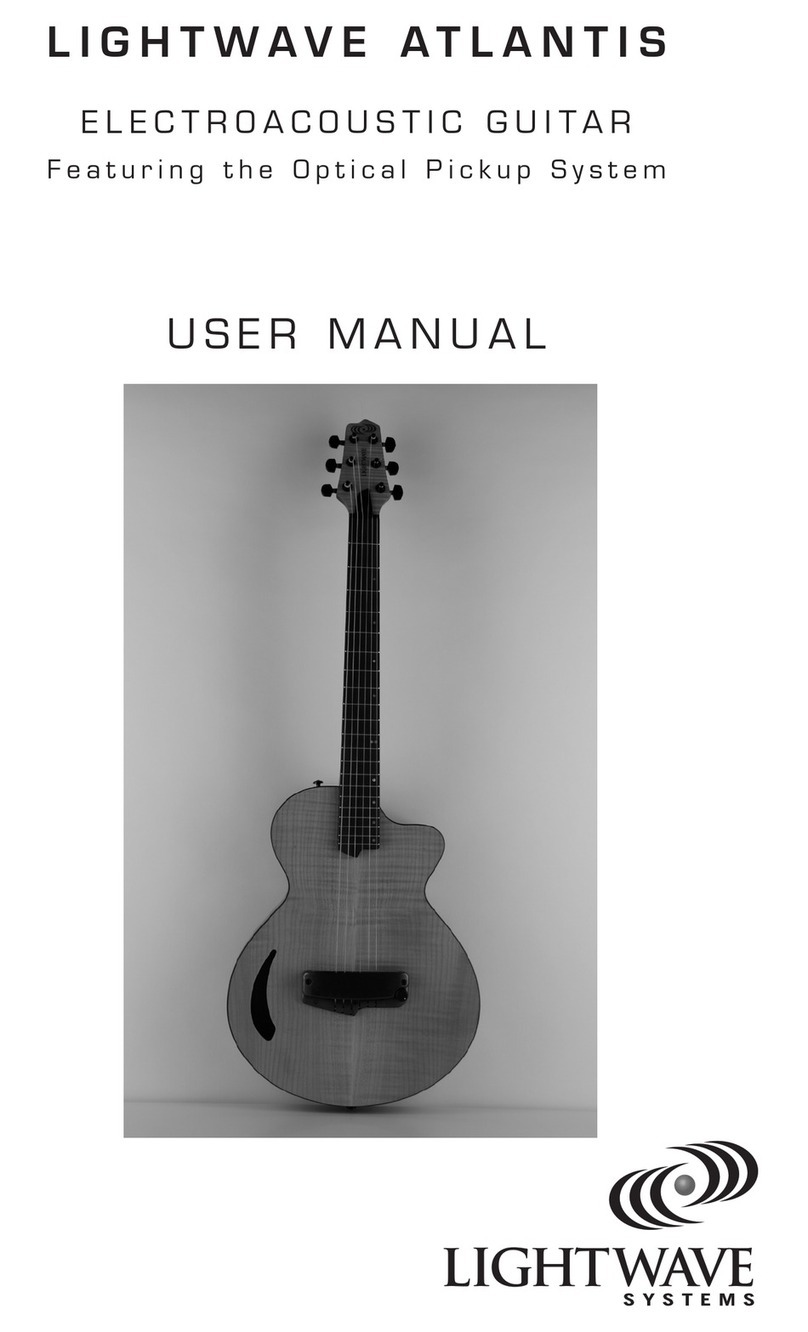Benedetto The Signature of Jazz Guitar Supplement



Owner’s Manual & Warranty

This superb instrument has been handcrafted by the
artisans of Benedetto Guitars from only the nest materials.
Made under the direction of Bob Benedetto to the
highest standards of excellence, this guitar is truly a
work of art, created to express the soul of the player.
Final inspection and approval remains the personal
responsibility and joy of Bob Benedetto.

Contents
4 Introduction
5 The Art of Robert Benedetto
6 Moisture Content & Humidity
8 Cracks in the Wood
8 A Note About Lacquer Finishes
11 General Maintenance
12 Tuning Machines
12 Changing Strings
13 Re-Stringing
14 Truss Rod Adjustment
16 Bridge Adjustment
19 Traveling with Your Guitar
19 Servicing Your Guitar
20 Benedetto
®
Lifetime Warranty

4
Introduction
Congratulations on purchasing the nest jazz guitar available anywhere in
the world. We sincerely hope that you are inspired to attain new musical
heights on your Benedetto guitar.
It is very important that you take a few moments to review this information.
Guitars are not all alike and there are care and maintenance issues you may
nd are specic to our guitars.
Please contact us if you have any questions after reading this booklet.
For specications of Benedetto instruments, visit benedettoguitars.com.
Thank you again for purchasing a Benedetto guitar. We wish you many years
of musical enjoyment.
Howard Paul, President/CEO
Benedetto Guitars, Inc.
The Signature of Jazz Guitar™

5
The Art of Robert Benedetto
A nely crafted guitar is the union of many things: music, design, art, sculp-
ture and architecture. The Benedetto guitar represents the pinnacle of this
union as now, more than ever, the archtop guitar is in a golden age of popu-
larity and artistic achievement.
Now in the fth decade of his career, Robert Benedetto has ultimately rede-
ned the nature of that quintessential American instrument, the archtop guitar.
Played by three generations of jazz masters, Benedetto guitars have been
crafted for such noted players as Johnny Smith, Joe Diorio, Martin Taylor,
Bucky Pizzarelli, Kenny Burrell, Chuck Wayne, Cal Collins, Jimmy Bruno, Jack
Wilkins, Howard Alden, Frank Vignola, Andy Summers and Earl Klugh. The
Benedetto guitar appears on countless recordings, videos, books, magazines,
TV & lm soundtracks and at concerts, museums (including the Smithsonian
Institution) and jazz festivals worldwide.
With original innovations and features such as the solid ebony tailpiece,
“honey blonde” nish, and exotic wood veneers for the headstock, Benedetto
instruments dene the continuum that runs through the instrument’s history
to the present and provide exciting glimpses into the future.

6
Moisture Content & Humidity
Wood is a porous, organic material and is affected dimensionally by changes in the
amounts of moisture it contains. Fine guitars made from solid woods are, without
a doubt, more susceptible to the effects of changes in humidity than laminated
wood instruments and therefore require ongoing attention to their condition.
The moisture content of wood is determined by the relative humidity and
temperature of the surrounding atmosphere.
Relative humidity is expressed as a percentage of the air’s capability to hold
moisture. For example, 30% relative humidity means that the air is holding
30% of the moisture it could possible hold at a given temperature.
The moisture content for wood and the relative humidity for air are measured
quite differently. In wood, a 7% moisture content is present at 30% relative
humidity and 72° F temperature, (about 22.2° C).
Protection from Temperature & Humidity
The greatest threats to a ne wood guitar are extremes of, and rapid changes
in, temperature and humidity.
High humidity can cause softening of the glues used in the construction of
the instrument. Also, as the woods absorb moisture from the air, it can cause
the top and back to expand and rise — making string action high.

7
Conversely, if you live in or travel with your guitars to a drier climate (either
hot or cold), there is another danger. In areas of low humidity, the evapora-
tion of moisture from the wood can cause shrinkage and cracking, no matter
how long the wood may have been previously aged. It also can cause the top
and back to string, making the string action low.
The collective experience of all the major guitar manufacturers today has
demonstrated that the ideal temperature to preserve the integrity of solid
wood acoustic guitars is room temperature, which is about 70° F (20.5°C).
The ideal relative humidity is about 40%–50%.
In the winter, the forced air systems used to heat most homes can drive tem-
peratures up and humidity levels dangerously low for guitars. A good measure
of protection against drying out your guitar is to use a room humidier.
When the instrument is not in use, we recommend that you keep it in its case.
If you are using a room humidier, check the relative humidity periodically and,
when needed, use one of the small guitar humidiers that are available from
many instrument dealers. (Be sure to follow their instructions carefully).
Do not leave the guitar out for long periods near a heating vent, radiator or
in direct sunlight near a window. Never leave your guitar in a car or in the
trunk of a car and do not expose it to excessive heat or cold.
IMPORTANT NOTE: DAMAGE CAUSED TO THE GUITAR AS THE RESULT
OF EXPOSURE TO TEMPERATURE OR HUMIDITY CHANGES WILL NOT
BE COVERED UNDER THE BENEDETTO
®
WARRANTY.

8
Cracks in the Wood
Cracks in the wood are typically caused by changes in temperature and
humidity. While a crack may initially be alarming, if it is taken care of promptly
it shouldn’t be a cause for undue concern. Cracks may easily be repaired
without compromising the structural or tonal integrity of the instrument.
If the crack is in the top, near the bridge, loosen all the strings to reduce
tension, (which could potentially exacerbate the problem), and have the
crack repaired as soon as you can.
IMPORTANT NOTE: CRACKS IN THE WOOD, WHICH OCCUR AS THE
RESULT OF TEMPERATURE OR HUMIDITY CHANGES, WILL NOT BE
COVERED UNDER THE BENEDETTO
®
WARRANTY.
A Note About Lacquer Finishes
Early handmade instruments with lacquer nishes have been prized and
sought after for decades by players and collectors, and part of the attrac-
tion has been the way lacquer ages. Gurus of vintage tone have consistently
chosen lacquer nished instruments over the years, as lacquer lets the wood
breathe and vibrate more freely.
Modern polyesters and polyurethanes are harder than lacquer and are much
less affected by environmental conditions, heavy use and aging.

9
Lacquer is a bit softer than polys and, while it does not seal the wood com-
pletely from climatic conditions, it provides an acoustical advantage by
allowing the most natural voice of the instrument to be heard.
Important Poits to Remember About Lacquer Finishes
1. FINISH CHECKING. All of the materials that make up a guitar expand and
contract with changes in temperature and humidity and they do this at different
rates. Wood naturally expands as it warms and it does so faster than the nish
placed over it. When this expansion occurs, the nish will stretch slightly; when it
cannot stretch anymore, it will split and fracture in tiny little lines over the wood.
This nish “checking”, or “crazing” as it is sometimes called, usually occurs
in winter and is typically the result of bringing an instrument inside from the
cold.To reduce the likelihood of checking, remember to allow plenty of time for
the instrument to acclimate to the new temperature before you open the case.
Although it does not affect the structural integrity or tone of the instru-
ment, nish checking does mar its appearance. Avoid exposing your instru-
ment to sudden temperature and humidity changes and you should be able
to minimize nish checking through the years.
2. SHRINKAGE. The cellular structures of solid woods (most notably
Spruce) naturally compress over time and as the instrument ages these
woods will shrink somewhat. As this happens, you will notice small ridges in
the surface of the instrument as the lacquer settles into the grain of the wood.
This is a perfectly normal part of the aging process.

10
3. CHEMICAL REACTIONS. Use only a non-silicone based guitar polish
and avoid using guitar straps, stands or wall hangers made from vinyl, plastic,
synthetic or surgical rubber tubing, as these materials may react with the
lacquer and mar the nish of your instrument.
4. CLEANING. Smoke, sweat, grease and grime will all contribute to and
accelerate the aging, discoloration and wear of the nish. If you want your
nish to age gracefully, take good care of it and keep it clean.
IMPORTANT NOTE: FINISH CHECKING, SHRINKAGE, DISCOLORATION
AND WEAR ARE ALL A NATURAL PART OF THE AGING PROCESS OF
LACQUER FINISHES AND, AS SUCH, WILL NOT BE COVERED UNDER
THE BENEDETTO WARRANTY.

11
General Maintenance
Clean the instrument after each use, making sure to wipe the ngerboard and
strings, as well as any of the plated parts, (i.e. machine heads, pickups, etc.),
with a soft dry cloth.
To clean your gloss nish, use a high quality non-silicone based guitar polish
available through your Benedetto Dealer.
When not playing the instrument, keep it tuned to pitch and in its case.
However, if you plan to store the instrument for long periods of time, loosen
the strings slightly to relieve some of the tension on the neck.
The natural oils in ebony ngerboards may dry out over time and rough,
exposed fret edges are evidence of dry, shrunken wood. It is a good idea to
give your thirsty fretboard a drink of lemon oil periodically to preserve its
integrity and natural beauty.
Remove the strings rst; then apply the oil to a clean lint free cloth. Rub into
the wood, letting it soak in for a couple of minutes, and then wipe to dry
any excess oil.

12
Tuning Machines
Benedetto
®
uses only the nest tuning machines. These machines are pre-lubricated,
die-cast, sealed tuners, which do not require periodic oiling for smooth operation.
A small tension adjustment screw is located at the end of each tuner’s button
that also holds the button in place. If the tension is too loose, the machine
may slip and go out of tune easily. If it is too tight, the button may become
very difcult to turn. Make sure that the adjustment is rm, but not too tight.
The plating on Benedetto tuning machines may become degraded from the
acids and oils in nger sweat. Wipe the machines off with a soft dry cloth
after each use to preserve their appearance and function.
Strings that have not been secured properly to the tuning machine post may easily
slip and go out of tune. This problem is commonly misdiagnosed as an issue with
the tuners. Check your string installation carefully. See illustrations 1, 2, and 3.
Changing Strings
A new set of strings can breathe renewed life into your instrument. That is why
many “tone-conscious” touring professionals change their strings before every
performance. While there is no set rule on how often to change strings, we have
found that most players do not change them nearly as often as they should.

13
Body oils, acids from sweaty hands and humidity all interact with the metals in
guitar strings and cause a corrosion and breakdown of the materials.
Don’t wait until your strings break and fall off from old age before you change them.
Worn, oxidized, pitted and dirty strings will not hold pitch accurately and simply
sound bad. If you are an average player, playing several times a week, we suggest
that you change the strings at least once a month.
When changing strings, we recommend that you remove and replace each
string one at a time, instead of all at once. This will prevent sudden and
potentially damaging rapid changes in neck tension. Each new string should
be tuned up to correct pitch before the next one is removed.
Re-Stringing
Benedetto jazz guitars have surface mounted bridges and slotted tailpieces
through which the strings are fed. The chambered solid body electrics use a
combination bridge/tailpiece.
To re-string your guitar, simply feed the ball end of the string through the
appropriate slot in the tailpiece or hole in the bridge, and pull the string
through and over to seat the ball.
To attach a string to the machine head, thread it through the hole or slot on the
machine head, running it halfway around the post, then underneath the main

14
length of the string. Next, pull the string end back and over the main length. See
illustrations 1, 2 and 3. Hold the string in place and tune to pitch.
Make sure that each string is seated well, stretched and snugged down on the
tuning machine post. This will prevent slipping and save you some tuning
frustrations down the road.
Truss Rod Adjustment
String tension exerts a tremendous bending force on the guitar neck.
Environmental conditions like temperature change and humidity variations
may also result in movement or bowing of the neck.
Your Benedetto
®
guitar has a double action truss rod extending the length
of the neck which counteracts this force, strengthens the neck and insures
straightness.
Should your guitar need a truss rod adjustment, rst remove the truss rod
cover located on the headstock above the nut. (The guitar should remain
tuned to pitch during this procedure.) Insert a 5/16"truss rod wrench over
the truss rod nut.
If the neck has a concave bow, turn the nut clockwise.
If the neck has a convex bow, turn the nut counter clockwise.

FPO
Restring illustration

16
Adjust the nut only a partial turn (¼or ½) at a time. Sight down the edge of
the fretboard after each adjustment to check the results.
If you encounter excessive resistance or if you have any doubts in your ability to
make this adjustment correctly, take your guitar to a qualied repair technician.
IMPORTANT NOTE: Truss rod adjustments are considered to be routine
maintenance and will not be covered under the Benedetto warranty.
Bridge Adjustment
Movable Bridge with Ebony Tailpiece
Benedetto
®
jazz guitars use height-adjustable movable bridges. A movable
bridge typically has an arched wooden base that is held in its proper position
on the instrument by the downward pressure of the strings.
To raise the height of the bridge, turn the adjustment wheels counterclock-
wise. To lower the bridge, turn the adjustment wheels clockwise.
IMPORTANT NOTE: If you have adjusted the height of the bridge up or
down, or if the bridge is bumped or moved during re-stringing, the intona-
tion will no longer be true.
To reset the intonation adjustment, check both the 12th fret harmonic and the
stopped 12th fret tuning of both the high and low E-strings, and adjust as follows:

17
If the pitch of the note at the 12th fret is sharp relative to the pitch of the
harmonic, loosen string tension and lightly tap the foot of the bridge to
move it back toward the tailpiece. Retune and adjust as needed until the two
pitches agree.
If the pitch of the note at the 12th fret is at relative to the pitch of the
harmonic, lightly tap the foot of the bridge to move it forward toward the
neck until the two pitches agree.
When the harmonic and 12th fret pitches agree on both the E-strings of a
movable bridge, the instrument is properly intonated.
IMPORTANT NOTE: When re-stringing a guitar with a movable bridge and
ebony tailpiece, change the strings one at a time. Do not remove all of the strings
at the same time, as both the bridge and tailpiece are held into proper position
by the downward pressure and tension of the strings.
TonePros AVT2
Use the handle of the TonePros
®
wrench (provided) sideways in the groove
of the stud tops to tighten and loosen the studs. The stud tops should be
snugly tightened so the bridge is not leaning under string tension, yet loose
enough to adjust the longitudinal set-screw. After adjusting the set screw, use
the open end of the wrench to adjust the bridge height. Now adjust each
string saddle as needed to intonate the guitar.

18
To set the intonation, check the harmonics and fretted notes at the 12th fret
of all strings. If the pitch of the note at the 12th fret is sharp, relative to the
pitch of the harmonic, adjust the saddle towards the butt-end of the guitar.
If the pitch of the note at the 12th fret is at, relative to the pitch of the
harmonic, adjust the saddle towards the neck.
With the bridge intonated, detune all the strings so there is little tension on
the bridge, tighten the stud tops, then re-tune.
Table of contents
